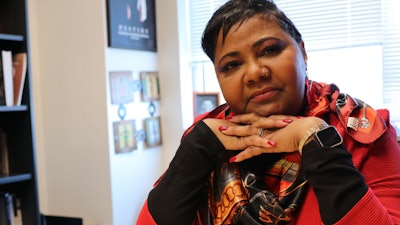Universities are making vocal commitments to recruit faculty who represent the diversity of the student population. At the same time, they struggle to retain the women and minoritized faculty who they have recruited. Moreno at al. (2006) referred to this as the ‘revolving door’ problem, finding that one in every two minority hires was a replacement for a previous minority who had left the institution.
Tenure is a key moment at which people exit university doors, perhaps because the doors slammed shut. Recent stories of prominent Black scholars being denied tenure (e.g., Nikole Hannah-Jones at University of North Carolina and Dr. Cornel West at Harvard) reveal a broader systemic pattern. Research on tenure denials confirms that women and minorities are more likely to be denied tenure, even when controlling for productivity.  Dr. Donna Y. Ford
Dr. Donna Y. Ford
Our focus is on the high-level biases that affect numerous minoritized groups and undermine the overall quality and fairness of promotion and tenure discussions. Our de-biasing recommendations are drawn from the well-established literature on groups, decision making, and culturally responsive, anti-racist practices. These are simple and often costless strategies, and many are already used widely in corporate hiring practices.
We present the problems/solutions as an easily accessible 10-point checklist, so that you can grade your own processes, identify your challenges, and proactively incorporate de-biasing practices in the spirit of equity, diversity, and inclusion.
1. Tenure meetings involve groupthink and status effects, with the loudest, most powerful voices dominating. Committee members often arrive unprepared. Those from marginalized groups may not feel psychologically safe to dissent.
Recommendations:
· Pre-work: University should provide departments with an anonymous, structured evaluation forms (with decision criteria and clear rubrics, just as is used to facilitate fairness in student grading) to rate the candidate both quantitatively and qualitatively. Committee members should evaluate the candidate independently, prior to group discussion to minimize peer pressure.
· Share the independent evaluations: Share each evaluator’s ratings, ensuring that all pertinent facts are surfaced.
2. Unclear standards, shifting yardsticks in discussion Dr. Ajit M.W. Chaudhari
Dr. Ajit M.W. Chaudhari
The same record can often be evaluated negatively or positively, based on the candidate’s likability. If people like the candidate, they are subjected to a low bar, and if they are disliked, their bar is insurmountable. Women/minoritized faculty are often subject to a moveable bar whereby standards continually shift, due to subjectivity in evaluation processes.
Recommendations:
· Standardized protocols: Just as standardized interview protocols (asking each interviewee the same questions in the same order) helps de-bias impressionistic interviewing, universities should provide departments with standardized protocols/scripts to organize meetings so that the same issues are discussed in the same order and in the same manner.
· Salient, consistent standards: Universities should provide departments with a presentation template where each standard in the promotion and tenure document is projected onto the screen as it is discussed. The criteria should be read aloud, prior to evaluating that dimension.
3. Narrow, self-serving yardsticks for assessing impact of scholarship, teaching, and service. Traditional standards (e.g., counting publications, citations, teaching ratings) are often based on self-justifying yardsticks. With respect to service, women and minorities face a ‘Diversity tax,’ wherein they are called to increased service/support for community members (including students) from under-served groups.
Recommendations:
· Recognize the biases of any single measure. Metrics should not be used as evidence without explanation of how they demonstrate impact and without consideration of the biases they may implicate.
· Given that there are many measures of impact and excellence, these should be captured in the evaluations. For example, with respect to teaching, go beyond student ratings: Qualitative comments; creative/novel teaching methods; mentorship of students; and improvement over time.
· Expectations should match assigned duties. If a faculty member is assigned more teaching and/or more service, and has less time available for scholarship, they should be evaluated accordingly. In many units, the scholarship alone or largely determines whether the faculty member receives a favorable evaluation. Evaluation of each component of a faculty member’s work (teaching, scholarship, service) should be based on the formal (assigned) and informal (unassigned) effort they devote/contribute to it.
· Create explicit subsections in Teaching, Scholarship, and Service sections of the dossier to ensure that diversity/equity contributions are included.
4. The tenure process is a social and political process. Civility and collegiality are regularly mentioned, and can be a catch-all term for likeability biases. Likability often is aligned with the candidate’s skill in politicking with their supervisors. Additionally, people like those who are similar, so this effect operates against women and minoritized faculty. People tend to dislike those who disagree with them, and these biases can be particularly strong against ‘outspoken’ minoritized and women faculty.
Recommendations:  Dr. Tanya Menon
Dr. Tanya Menon
· Eliminate ambiguously defined ‘collegiality’ from these discussions and establish clear standards.
· To define collegiality more broadly than upward politicking in the hierarchy, include 360-ratings with peers, junior faculty, students, and administrative staff.
· Identify objective indicators to surface invisible work and other hidden community contributions.
5. External letters are free-form — varying in length, criteria, and stringency. They often say more about the letter writer than the candidate.
Recommendations:
· Utilize a standard template from the university/college/department to ensure that external letter writers address the same questions about each candidate.
· Use bias-checking software to identify potentially discriminatory language in these letters.
· Do not draw inferences based on unclear information from these letters (e.g., whether reviewers decline to write for the candidate, length of the letter).
· Recognize that there may be fewer appropriate letter writers in the pool for diverse applicants.
· Recognize that minoritized faculty seldom/rarely have the same social and cultural capital as their White peers. They must not be penalized because their letter writers come from ‘lower-tiered’ institutions and/or are less well-known. To do otherwise is elitist and biased.
6. Majority group members are evaluated by fellow majority group members at each step of the process, while minoritized faculty members are evaluated by majority (outgroup) members. (This occurs both in internal evaluations and in the selection of outside letters). One of the most pervasive effects in psychology is ingroup bias, whereby ingroup members tend to view fellow ingroup members favorably and give them benefits of the doubt versus outgroup members.
Recommendations:
· Ensure diverse representation in outside letters for all candidates, so that minoritized faculty members are not being evaluated by outgroups, while majority group members benefit by evaluations from ingroup members.
· Expand criteria for external evaluators of scholarship beyond eminent tenured faculty in the broader field where appropriate. People outside of academia may be better positioned to evaluate the impact of candidate’s scholarship.
· Carefully assess why disconnects occur between external and internal evaluators.
7. The very people evaluating minoritized faculty may be those who have subjected them to overt bias or disrespect. Even if this uncollegial behavior isn’t overtly racial or gender-biased, research on selective incivility finds that people feel particularly entitled to exhibit disrespect to women, minorities, and particularly women from minoritized groups. If women/minoritized faculty call these behaviors out, they themselves are deemed uncollegial.
Recommendations:
· Participation in promotion and tenure deliberations should be considered a privilege, not a right. Individuals who have a history of harassing and/or of creating a hostile environment should lose that privilege.
· Candidates should have a right to remove specific individuals from the pool if prior harassment will impact the evaluation.
· If the entire group is contaminated due to prior harassment, create mechanisms for third party accountability rather than using internal individuals who are conflicted by existing relationships.
8. In our personal communications with senior university administrators, they have noted that more “procedural violations” emerge in promotions cases of minoritized vs. majority-group candidates. Universities often have policies of “re-doing” the tenure meeting in the event of a procedural violation. This approach compounds biases, rather than rectifying them. Departmental members will know others’ positions, accentuating groupthink.
Recommendations:
· End re-do meetings. Instead, explain why the violation occurred. The biases the violation created should be identified by the department, with input from the minoritized candidate. The violation should be addressed at the next level, not ‘corrected’ via a re-do at the level that created the biased process in the first place.
· Documentation is essential. Measure the number of procedural violations occurring in tenure cases of majority vs. minoritized candidates.
9. Candidates are often assigned a point of contact in the department as their advocate, but their role is often limited, and they may not be equipped to address the unique challenges faced by minoritized candidates.
Recommendations:
· Expand the departmental representative point of contact’s role to include diversity/equity considerations. Ensure that all members of the tenure committee understand the advocate’s role.
· The advocate should identify potential biases in the evaluation as they observe them, and ensure that the department has invited a broad, diverse set of external reviewers.
10. Department-mandated trainings are often ineffective, and the same biases persist.
Recommendations:
· Rather than a one-time training at the beginning of the year, incorporate de-biasing techniques directly into tenure policies and procedures (e.g., standardized protocols, visually salient criteria).
· Make the biases salient by giving participants a list of common biases that negatively impact fair reviews, with examples (e.g., National Institutes of Health standard training for all scientific reviewers) prior to the discussion.
Conclusion:
Tenure processes have remained essentially unchanged for decades in many universities/colleges/departments. The research-based best practices we propose can help change tenure processes from an unstructured, backroom free-for-all replete with politics, groupthink, and bias, to an intentionally structured, equitable process.
Dr. Tanya Menon is a Professor in the Fisher College of Business at The Ohio State University
Dr. Ajit M.W. Chaudhari is a Professor in the School of Health and Rehabilitation Services and Associate Dean of HRS Diversity & Inclusion in the College of Medicine at The Ohio State University.
Dr. Donna Y. Ford is the EHE Distinguished Professor in the College of Education & Human Ecology at The Ohio State University.


















